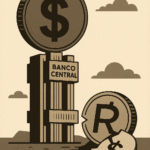Series: The Productivity Trap in Brazil – Part 1
Introduction
The word “productivity” is repeated in economic speeches, corporate reports and government plans — but few understand its true meaning. It is a simple but crucial concept: productivity is the ability to produce more with less. In an economy, this means generating more wealth with less time, resources and effort.
What is productivity?
Productivity is, in essence, a measure of efficiency. In economic terms, it can be broken down into three main categories:
- Labor productivity: how much is produced per hour worked or per worker.
- Capital productivity: how much return is extracted from each unit of invested capital (machinery, equipment, facilities).
- Total factor productivity (TFP): a broader measure that calculates the efficiency gain in the joint use of labor and capital.
According to the IPEA report, Brazil has historically stagnated in labor productivity. Between 1995 and 2018, average annual growth was less than 1% — a stark contrast with countries such as South Korea and China, which modernized their production structures at an accelerated pace in the same period.
Why is productivity so important?
Productivity is the silent engine of sustainable economic growth. A country that does not improve its productivity is doomed to grow less, pay lower wages and see its population consume less.
Real wages are directly linked to worker productivity. It is impossible to consistently increase the average income of a population if each worker is not able to produce more value over time.
Sustainable economic growth also depends on this progress. When there are no efficiency gains, growth is based solely on increased consumption or government spending — which leads to inflation, deficits and debt.
According to the report “OECD Quantitative Indicators for Brazil”, Brazilian productivity remains below the average of emerging countries in Asia and Latin America. While Brazil produces around US$$20 of value per hour worked, countries such as Chile, Mexico and Turkey have already surpassed this mark. The gap in relation to the US is even more alarming: Brazilian productivity represents only 25% of that of the US.
Productivity isn’t effort — it’s structure
A common mistake is to confuse productivity with individual effort. Brazilian workers are not lazy — on the contrary, they are among those who work the most per year. The problem is structural: low qualifications, inefficient infrastructure, an environment hostile to entrepreneurship, complex taxes and a State that penalizes those who produce.
This reality is directly reflected in the basic formation of the population. According to a recent survey published by G1, 3 out of 10 Brazilians are functionally illiterate — that is, they cannot interpret a simple text or perform basic mathematical operations. This means that millions of Brazilians are not even able to develop essential skills for productive work.
While countries that prioritized economic freedom, trade openness and institutional modernization advanced in productivity, Brazil opted for a development model based on government spending and protectionism — a path that generates immediate consumption but impoverishment in the long term.
Conclusion
Productivity is the dividing line between rich and poor countries. There is no path to prosperity without producing more with less. It is urgent that Brazil put aside ideological discourses and seriously address the root of its backwardness: a system that penalizes efficiency and rewards mediocrity.
Read also: Article 2 – Brazil works a lot and produces little: a portrait of stagnation





